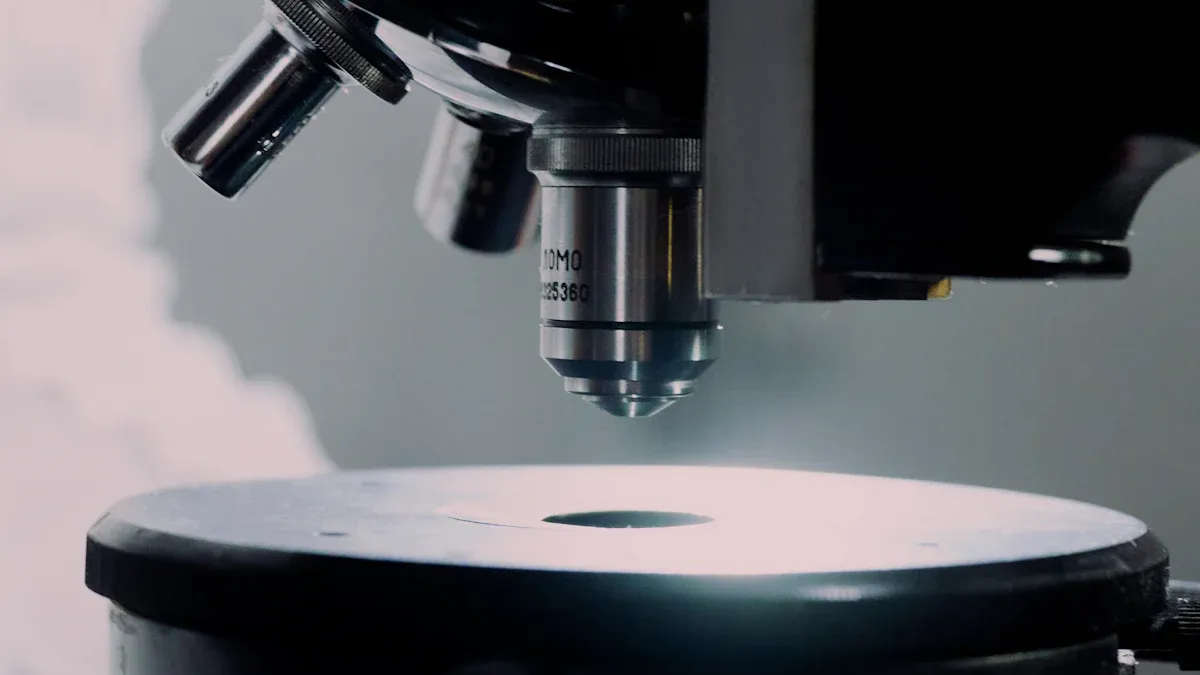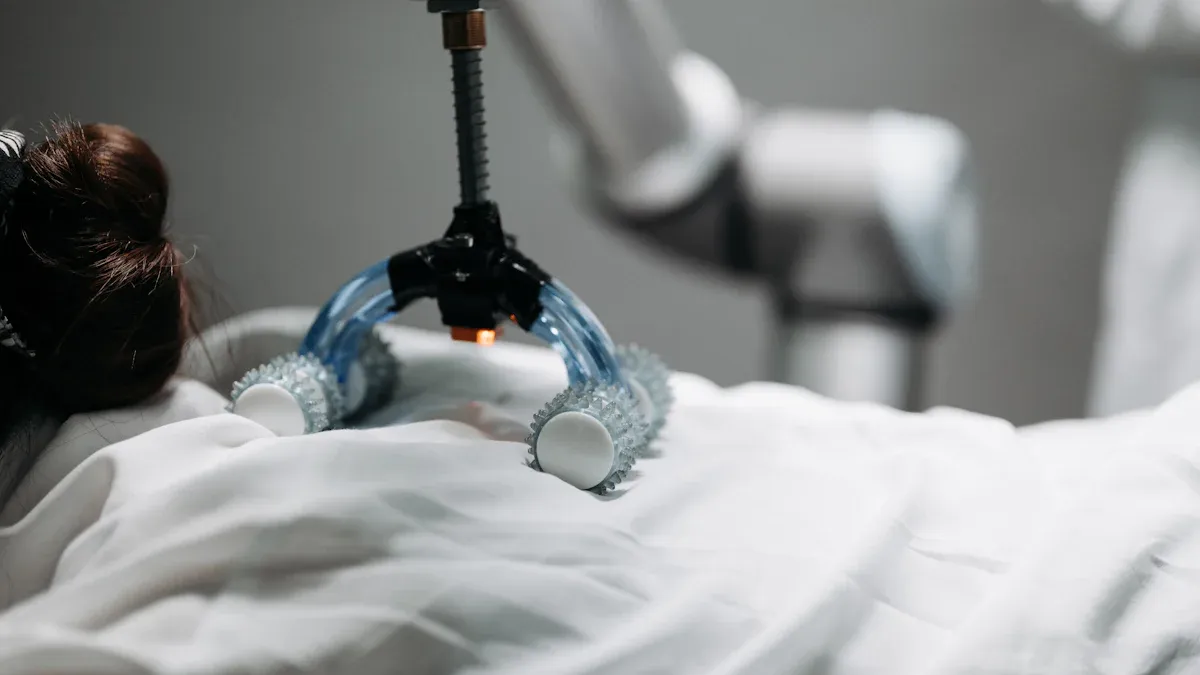High-Precision Nitinol Tubing for Enhanced Medical Applications

High-precision laser-cut nitinol tubing for medical devices is revolutionizing healthcare by merging cutting-edge material properties with advanced manufacturing. Recent innovations allow for customization of nitinol tubes, improving medical device performance. For instance, embedded sensors in these tubes enable real-time monitoring during surgeries, ensuring better safety and decision-making. Additionally, the growing demand for minimally invasive procedures, driven by an aging population and rising chronic illnesses, underscores nitinol tubing's critical role. Manufacturers are also adopting eco-friendly production methods to meet sustainability demands, further enhancing its appeal in modern medicine.
Key Takeaways
Nitinol tubing has special traits like bending back to shape and stretching without breaking, making it great for flexible and strong medical tools.
Using lasers to cut nitinol tubing makes it very precise. This helps create detailed shapes needed for advanced medical uses.
Nitinol is safe for the body and doesn’t rust. This makes it good for implants, reducing bad reactions and lasting a long time.
Small surgeries with nitinol tubing help patients feel better faster. They heal quicker and spend less time in the hospital.
The need for custom nitinol tubing is growing. This helps create new healthcare ideas and better results for patients.
Unique Properties of Nitinol for Medical Devices
Shape Memory and Its Impact on Device Functionality
Nitinol's shape memory property allows medical devices to adapt to specific anatomical requirements. This unique characteristic enables devices to return to their pre-defined shape after deformation, ensuring optimal performance during procedures. For example, stents and guidewires made from nitinol can be compressed for insertion and then expand to their intended shape once deployed, enhancing patient comfort and procedural accuracy.
Studies reveal that functional fatigue in shape memory alloys (SMAs) arises from transformation-induced defects, which can impact device reliability. Addressing these degradation mechanisms is essential for improving the longevity of nitinol-based devices. Furthermore, research demonstrates that the shape-memory effect is observable even at microscopic scales, such as in twisted ferroic nanocomposites. This capability opens doors for innovative applications, including micro- and nanorobots, which rely on precise actuation forces and recoverable strains to perform complex tasks in medical environments.
Superelasticity for Flexibility and Durability
Superelasticity is another defining feature of nitinol, allowing devices to undergo significant deformation while maintaining their structural integrity. This property is particularly beneficial for medical devices navigating complex anatomical structures, such as stents and catheters. Superelasticity ensures these devices can bend and flex without kinking or breaking, making them ideal for minimally invasive procedures.
Manufacturing processes like cold working and heat treatment further enhance nitinol's superelastic properties. These techniques optimize shape recovery after deformation, which is critical for devices exposed to mechanical loads. Statistical data highlights nitinol's contribution to durability and flexibility:
Evidence Description | Contribution to Durability and Flexibility |
|---|---|
Superelasticity allows significant deformation and recovery | Ensures devices like stents maintain structural integrity while navigating complex anatomy |
Cold working and heat treatment enhance superelastic properties | Optimizes shape recovery after deformation, critical for stents in blood vessels |
Nitinol SMA wire offers greater durability and resistance to deformation | Ensures longevity and reliability in critical medical applications |
Additionally, nitinol wires provide exceptional resistance to deformation, ensuring reliability in high-stress applications. These qualities make nitinol indispensable for devices requiring both flexibility and durability.
Biocompatibility and Corrosion Resistance in Medical Applications
Nitinol's biocompatibility ensures its safe use in medical devices that interact directly with human tissues. This property minimizes the risk of adverse reactions, making nitinol ideal for implants and long-term medical applications. Its corrosion resistance further enhances its suitability for environments exposed to bodily fluids, ensuring device longevity and reducing maintenance needs.
Medical-grade nitinol undergoes rigorous testing to meet biocompatibility standards. Its ability to resist corrosion is attributed to the formation of a protective oxide layer, which shields the material from degradation. This feature is particularly valuable for cardiovascular devices, such as stents and heart valves, which must perform reliably in challenging conditions.
The combination of biocompatibility and corrosion resistance makes nitinol a preferred material for modern medical devices. These properties not only improve patient safety but also extend the lifespan of critical medical tools, supporting advancements in healthcare technology.
High-Precision Laser-Cut Nitinol Tubing for Medical Devices

The Laser Cutting Process and Its Advantages
Laser cutting has become a cornerstone in the manufacturing of nitinol tubing for medical devices. This process uses a focused laser beam to cut through nitinol with unparalleled precision. Unlike traditional machining methods, laser cutting does not involve physical contact between the tool and the material. This eliminates tool wear, ensuring consistent accuracy over time.
One of the most significant advantages of laser cutting is its ability to produce components with tighter tolerances and smoother surfaces. These qualities are essential for meeting the stringent standards required in medical applications. For instance, cardiovascular stents and surgical instruments demand flawless finishes to ensure safety and effectiveness. The precision of laser cutting also minimizes the need for post-processing, as clean cuts are free from excessive burring. This reduces production time and enhances the overall quality of the final product.
Additionally, laser cutting offers high repeatability, which is crucial for medical devices. Uniformity across parts ensures reliability, especially in life-saving applications. Manufacturers rely on this process to create intricate designs and maintain consistent quality, even in large-scale production.
Tip: The non-contact nature of laser cutting not only improves precision but also reduces the risk of material contamination, making it ideal for medical-grade nitinol tubing.
Achieving Tight Tolerances and Complex Geometries
High-precision laser-cut nitinol tubing excels in achieving tight tolerances and complex geometries. This capability is vital for medical devices that require intricate designs to perform specific functions. For example, self-expanding stents rely on nitinol's shape memory effect to return to a predetermined shape when deployed. Laser cutting enables the precise fabrication of these devices, ensuring they meet exact specifications.
The following table illustrates the tight tolerances achievable with laser cutting for nitinol tubing:
Outer Diameter (OD) (mm) | OD Tolerance (mm) | ID Tolerance (mm) |
|---|---|---|
OD≤0.3 | ±0.005 | ±0.010 |
0.3≤OD≤0.5 | ±0.007 | ±0.015 |
0.5≤OD≤1.5 | ±0.015 | ±0.020 |
1.5≤OD≤2.5 | ±0.020 | ±0.030 |
2.5≤OD≤3.5 | ±0.020 | ±0.040 |
These tight tolerances ensure that nitinol tubing can meet the demands of advanced medical applications. The ability to create complex geometries further highlights the versatility of laser cutting. For instance, nitinol components used in minimally invasive surgical instruments often feature intricate patterns that enhance flexibility and functionality. Laser cutting makes it possible to achieve these designs with remarkable accuracy.
Minimizing Thermal Damage and Post-Processing Needs
Thermal damage is a common concern when working with heat-sensitive materials like nitinol. Excessive heat can alter the material's properties, compromising its performance. Laser cutting addresses this issue by using controlled energy levels to minimize heat-affected zones. This ensures that the material retains its unique properties, such as shape memory and superelasticity.
The precision of laser cutting also reduces the need for extensive post-processing. Clean cuts eliminate the need for additional finishing steps, such as deburring or polishing. This not only saves time but also reduces production costs. Furthermore, the reduced thermal impact preserves the integrity of the material, ensuring that it performs reliably in medical applications.
Manufacturers prioritize laser cutting for its ability to balance precision and efficiency. By minimizing thermal damage and post-processing needs, this method streamlines the production of high-precision laser-cut nitinol tubing for medical devices. This ensures that the final products meet the highest standards of quality and safety.
Applications of Nitinol Tubing in Modern Medicine

Cardiovascular Devices: Stents and Guidewires
Nitinol tubing plays a pivotal role in cardiovascular devices, particularly stents and guidewires. Its shape memory and superelasticity allow stents to expand precisely within blood vessels, ensuring optimal blood flow. Guidewires benefit from nitinol’s flexibility, enabling smooth navigation through complex vascular pathways. Clinical trials confirm the effectiveness of nitinol-based stents in reducing restenosis rates, which significantly improves long-term patient outcomes.
The global market for nitinol medical devices is expanding due to advancements in technology and the growing preference for minimally invasive procedures.
Nitinol-based devices demonstrate excellent biocompatibility, minimizing adverse reactions and ensuring safe interaction with human tissues.
Over 1.5 million cardiovascular stents made from nitinol are implanted globally each year, highlighting its widespread adoption.
These attributes make nitinol tubing indispensable for life-saving cardiovascular applications.
Minimally Invasive Surgical Instruments
Minimally invasive surgical instruments rely on nitinol tubing for precision and reliability. Its ability to achieve tight tolerances and complex geometries ensures the creation of tools that perform intricate tasks with accuracy. Nitinol’s superelasticity allows instruments to bend and flex without compromising their structural integrity, making them ideal for procedures requiring delicate maneuvers.
Device Type | Success Rate | Notes |
|---|---|---|
Silverway guidewire | High vessel crossing success rate | |
Catheters | 92% | Successful delivery in most cases |
Nitinol implants | 30% lower rejection rate | Improved outcomes compared to traditional metals |
The high success rates of nitinol-based surgical instruments underscore their reliability and effectiveness in modern medicine. These tools enhance procedural accuracy while reducing patient recovery times.
Orthopedic and Endoscopic Innovations
Orthopedic and endoscopic devices benefit greatly from nitinol tubing’s unique properties. Its biocompatibility and corrosion resistance make it suitable for implants and tools exposed to bodily fluids. Nitinol tubing accounts for 75–80% of the medical devices market share, reflecting its dominance in the industry.
The global orthopedic implants market is valued at $59.3 billion in 2023, with a projected growth rate of 5.7% CAGR through 2030.
Nitinol tubing enables the development of flexible endoscopic tools that navigate tight spaces with ease.
Extensive research supports its integration into innovative devices, ensuring improved patient outcomes and reduced complications.
High-precision laser-cut nitinol tubing for medical devices continues to drive advancements in orthopedic and endoscopic technologies, paving the way for safer and more effective treatments.
Benefits of High-Precision Nitinol Tubing for Patient Care
Enhanced Device Performance and Reliability
High-precision nitinol tubing enhances the reliability of medical devices by ensuring consistent performance under demanding conditions. Its durability and precision are critical for minimally invasive procedures, where structural integrity must be maintained during repeated use. The material’s superelasticity and shape memory properties allow devices to navigate complex anatomical pathways without compromising functionality.
Description | |
|---|---|
Material Composition | Variations in nickel-titanium alloy content optimize shape memory properties. |
Dimensional Accuracy | Ensures stents meet exact size and shape requirements for proper deployment. |
Surface Quality | Smooth finishes improve biocompatibility and reduce infection risks. |
These metrics highlight the importance of nitinol tubing in creating reliable medical devices. For example, surgical tools made with nitinol tubing resist kinking and maintain stability in challenging anatomical pathways. This ensures consistent device performance, reducing procedural errors and improving patient outcomes.
Improved Patient Comfort and Recovery Times
Nitinol tubing significantly improves patient comfort and accelerates recovery times. Its flexibility allows stents and catheters to conform to complex vascular pathways, minimizing trauma to surrounding tissues. This reduces post-operative pain and promotes faster healing.
Minimally invasive procedures using nitinol tubing also shorten hospital stays. The material’s superelasticity ensures stents maintain their shape under pulsatile stresses, enabling consistent blood flow. Patients benefit from quicker recovery and a faster return to daily activities.
Metric | Nitinol Devices | Traditional Materials |
|---|---|---|
Recovery Improvement | N/A | |
Pain Level Reduction | Quicker recovery | N/A |
Risk of Complications | Lower | N/A |
These advantages make nitinol tubing indispensable for modern medical devices, ensuring better patient experiences and outcomes.
Supporting Cutting-Edge Medical Advancements
High-precision laser-cut nitinol tubing for medical devices drives innovation in healthcare technology. Its unique properties enable the development of advanced tools and implants that improve procedural success rates. For example, clinical studies demonstrate the effectiveness of nitinol-based stents in treating vascular conditions.
Mewissen (2004): 137 lower limbs treated with SMART stents achieved 98% technical success and 92% patency at six months.
Zeller et al (2008): 110 patients with SFA lesions showed 96% technical success and 23.3% restenosis at one year.
Kickuth et al (2007): 35 patients with severe claudication achieved 82% patency at six months and 100% limb salvage rates.
The global nitinol market is projected to reach $4.76 billion by 2034, with a compound annual growth rate of 7.60%. The tubing segment is expected to lead this growth due to its adoption in various medical procedures. These advancements highlight nitinol tubing’s role in fostering cutting-edge medical technologies and improving patient care.
High-precision nitinol tubing drives innovation in medical technology. Its unique properties and advanced manufacturing techniques improve device performance and patient outcomes. Forward-looking trends further enhance its role in healthcare:
Growing demand for minimally invasive procedures.
Continuous reforms in endograft designs with bioresorbable materials.
Trend Description | Impact on Nitinol Tubing |
|---|---|
Advancements in graft materials | Enhances customization and device performance |
Improved imaging-guided deployment | Increases procedural efficiency and accuracy |
Integration of AI-powered surgical tools | Supports precision in surgeries using nitinol tubing |
Nitinol tubing remains essential for life-saving applications, ensuring better outcomes and paving the way for future advancements.
FAQ
What makes nitinol tubing ideal for medical devices?
Nitinol tubing combines shape memory, superelasticity, and biocompatibility. These properties ensure flexibility, durability, and safe interaction with human tissues. Its corrosion resistance further enhances its reliability in medical environments.
How does laser cutting improve nitinol tubing manufacturing?
Laser cutting achieves tight tolerances and complex geometries with precision. It minimizes thermal damage and reduces post-processing needs, ensuring high-quality components for medical applications.
Can nitinol tubing be customized for specific medical procedures?
Yes, manufacturers can tailor nitinol tubing dimensions, geometries, and properties to meet specific procedural requirements. This customization supports advanced medical applications like stents, guidewires, and surgical instruments.
Is nitinol tubing safe for long-term use in implants?
Nitinol tubing is highly biocompatible and resists corrosion. These features make it safe for long-term use in implants, reducing risks of adverse reactions and ensuring device longevity.
What are the future trends in nitinol tubing applications?
Future trends include patient-specific customization, integration with AI-powered surgical tools, and advancements in bioresorbable materials. These innovations aim to improve procedural accuracy and patient outcomes.
See Also
The Importance of Nitinol Tubing in Modern Medicine
The Process Behind Nitinol Tubing Production for Healthcare
Nitinol Tubing's Impact on the Future of Medical Devices

